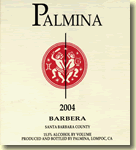|
|
Barbera, Santa Barbara County, |
 |
|
Wine Details
Price:
$26.00 per bottle
Description:
The 2004 Barbera is a dark ruby red color with beautiful purple highlights. It is a dark, rich wine that eagerly displays the characteristics of the two vineyards. The cool climate of Santa Rita Hills lends the dark color and the sprightly acidity of the wine, while the warmer Alisos vineyard adds softness. The nose is inviting and fresh, forecasting concentrated fruit on the palate. Intense yet delicate blueberry, raspberry and spicy characteristics abound. At first taste, your taste buds start yearning for food – as this wine is designed to make you crave a meal. Young mission figs, black cherries, a bit of black strap molasses and tar are balanced by firm and bright acidity. This balance of dark fruit and natural acidity makes this wine an etension of the plate, enabling you to feel satisfied and happy during and at the end of a meal.
|
|
|
Reviews
|

|
|
|
Back to Palmina information
|
|
|